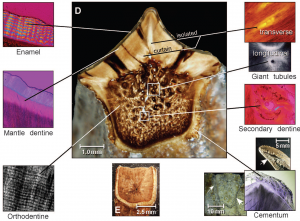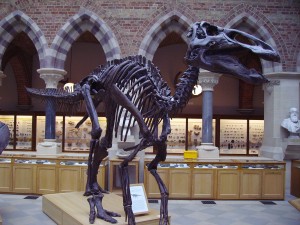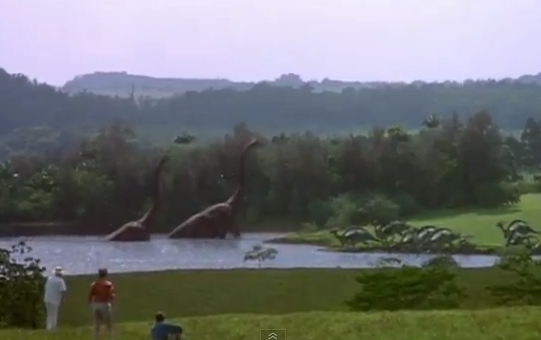The title of this makes no sense, but kind of emphasises the main point of this post. It’s pretty much a summary of a new paper, one on the feeding habits of hadrosaurid dinosaurs. These are the big advanced ornithopods, often considered to be the ‘bland’ lineage of ornithischians, and referred to as the ‘cows of the Cretaceous’. They also happen to be my favourite group of dinosaurs, simply because, with the exception of the more avian theropods, they are the only ones who are vaguely analogous to extant organisms; specifically, ungulates. This means that by comparing certain aspects of their morphology, we can make inferences about their behaviour and lifestyle, which is certainly one of the cooler aspects of Palaeontology. Unfortunately, this new article is published in Science, which means you either have to fork out for it, can’t read it, or have to go to some other media outlet (and let’s face it, no-one does that anymore in the era of blogging, right? Right??) ScienceNOW have been nice enough to cover it here though.
Hadrosaurs were pretty cool dinosaurs. They radiated in the Cretaceous, from iguanodontian descendants (like the infamous, er, Iguanodon), and from even earlier smaller bipedal forms such as Hypsilophodon. These varied species formed a group called Ornithopoda, one of the five major lineages of Ornithischia, which in turn is one of the two major branches of Dinosauria (dinosaurs!). Ornithopods exhibited a range of body plans, life habits, feeding strategies, herding structures, and may have even been half-decent parents. Hadrosaurs were the culmination of a rather successful 50 million years or so of ornithopod evolution, and it is highly likely that the increasing complexities of their feeding habits were the key to their success. There have been a tonne of previous studies looking at the mechanics of how hadrosaurs chomped and chewed their way across the great Cretaceous landscapes, but this new study led by Greg Erickson of Florida State University (USA) reveals hitherto unknown complexities in the beasties’ tooth structure, which may have been a massive contributing factor to their success.
Hadrosaurs were probably capable of chewing pretty much anything vegetationy that happened to being in the way of their mandibular mowers. If you’re lucky enough to find some of their petrified poop (coprolites) or stomach contents (cololites), you can infer that they used to dine on salads comprising a blend of early angiosperms (flowering plants) and gymnosperms (seed-producing plants). It has been suggested that the interaction of plants and hadrosaurs drove the radiation of certain plant groups (especially angiosperms), or vice versa, but this hypothesis is still in early stages of evaluation. For this feeding style, hadrosaurs had immense ‘tooth batteries’: up to 1400 replaceable teeth packed densely into great grinding mills. Mechanical studies of hadrosaur skulls, and observation of tiny scratches on individual teeth has given some insight into the ‘pleurokinetic’ mobility of the skull and ‘transverse power stroke’ method of grinding.
In mammals, teeth are made of four major tissues: orthodentine, enamel, soft secondary dentine and coronal cementum, each spatially and functionally defined. To compare hadrosaur teeth with this, the team drilled into teeth to test their hardness (microtribological wear testing), and observed cross-sections of the teeth (yes, that means they chopped some up!) using microscopy to ascertain their different material compositions. They used a modelling method to determine how varying tissue distributions creates different wear surface features.

Sections through an Edmontosaurus tooth showing the different tissues. E shows an example of a variant missing the giant tubules (click for larger image). Copyright: Erickson et al 2012, Science
The surprising result was that hadrosaur teeth, specifically that of Edmontosaurus, contained six different tissues. As well as the four mammalian tissues, these included giant tubules (infilled pulp cavity branches) and a thick mantle of dentine. Hadrosaurs have the most complex teeth, structurally, compositionally, histologically, of any animal currently known. Think about that next time you use the phrase ‘evolutionary dead-end’. Another cool thing is that the distribution of these tissues changed through time as they were worn down by abrasive plant matter (which may have contained grit and silica grains in the grass), which could suggest that feeding styles changed through growth (ontogeny) as different teeth assumed different roles. This is additionally cool, as this variation may be reflected in a phylogenetic context in the stepwise increasing complexity of ornithopod feeding styles through time, although this has yet to be tested substantially. This complexity may also be the primary driver for their radiation and diversification – hadrosaurs certainly got bigger through time, most likely as a result of being able to vigorously and efficiently process huge swathes of unsuspecting plants.
Hadrosaurs, therefore, were unique among all reptiles, in developing an advanced internal tooth structure comprising 6 different tissue compositions, providing them with one of the most sophisticated dental apparatuses to date. Even more than me, you, Adam Richman, or a horse. Still think ornithopods are boring?
Reference
Erickson, G. M. et al. (2012) Complex dental structure and wear biomechanics in hadrosaurid dinosaurs, Science, 338 (5), 98-101, DOI: 10.1126/science.1224495
Note: This blog post has been submitted to the NESCent Blog Contest. Details available here: http://blogcontest.nescent.org/submit-your-post/




flower tea
I prefer flower tea to green tea